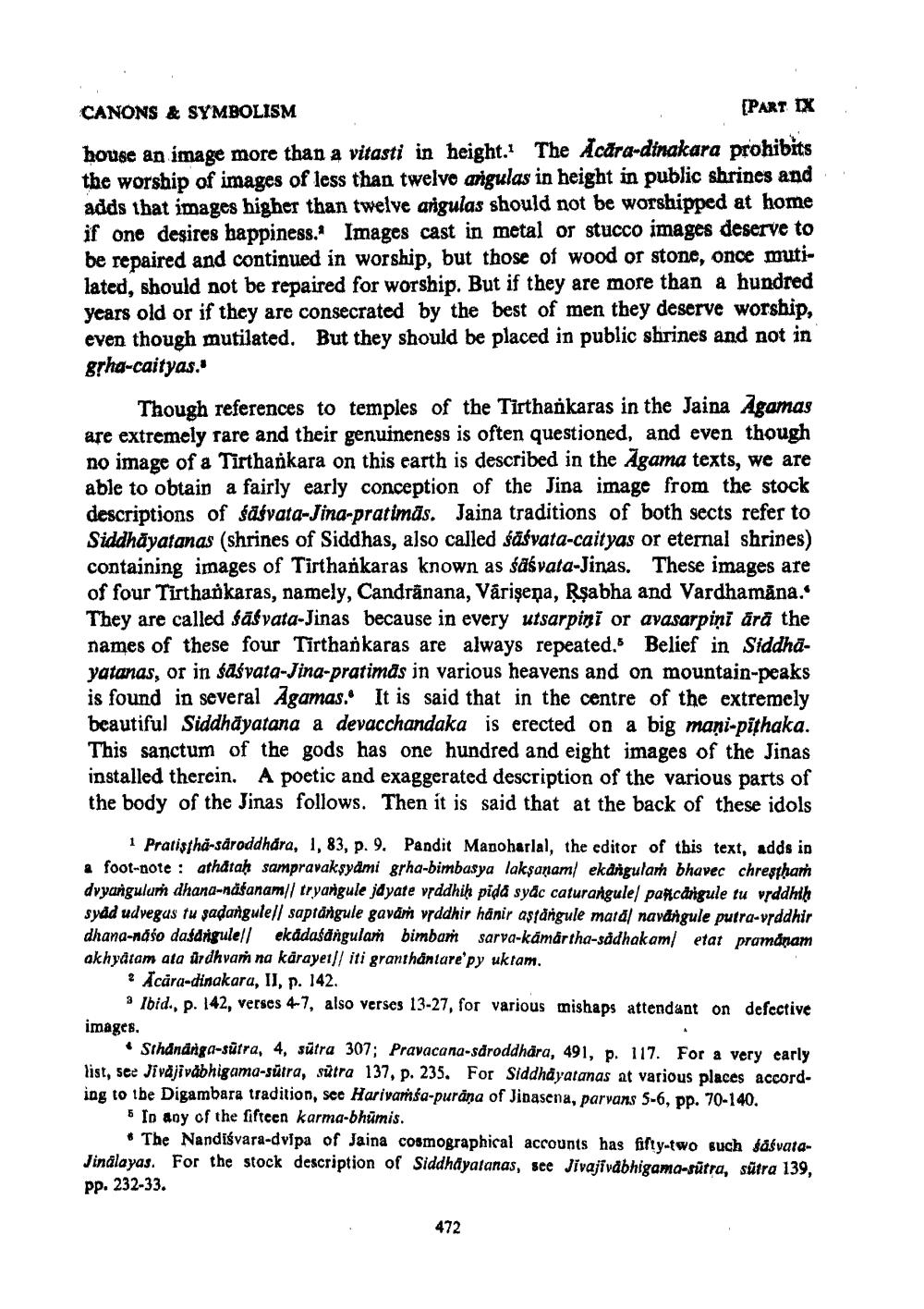________________
CANONS & SYMBOLISM
[PART IX house an image more than a vitasti in height. The Acara-dinakara prohibits the worship of images of less than twelve argulas in height in public shrines and adds that images higher than twelve angulas should not be worshipped at home if one desires happiness. Images cast in metal or stucco images deserve to be repaired and continued in worship, but those of wood or stone, once mutilated, should not be repaired for worship. But if they are more than a hundred years old or if they are consecrated by the best of men they deserve worship, even though mutilated. But they should be placed in public shrines and not in gsha-caityas."
Though references to temples of the Tirthařkaras in the Jaina Agamas are extremely rare and their genuineness is often questioned, and even though no image of a Tīrthankara on this earth is described in the Agama texts, we are able to obtain a fairly early conception of the Jina image from the stock descriptions of sasvata-Jina-pratimās. Jaina traditions of both sects refer to Siddhāyatanas (shrines of Siddhas, also called säsvata-caityas or eternal shrines) containing images of Tirthankaras known as śāśvata-Jinas. These images are of four Tirtharkaras, namely, Candránana, Vārişeņa, Rşabha and Vardhamana.' They are called sāsyata-Jinas because in every utsarpini or avasarpini ārā the names of these four Tirthankaras are always repeated. Belief in Siddhayatanas, or in sāśvata-Jina-pratimas in various heavens and on mountain-peaks is found in several Agamas. It is said that in the centre of the extremely beautiful Siddhāyatana a devacchandaka is erected on a big mani-pithaka. This sanctum of the gods has one hundred and eight images of the Jinas installed therein. A poetic and exaggerated description of the various parts of the body of the Jinas follows. Then it is said that at the back of these idols
1 Pratistha-säroddhara, 1, 83, p. 9. Pandit Manoharlal, the editor of this text, adds in a foot-note : athatah sampravaksydmi grha-bimbas ya laksanam/ ekangular bhavec chrestham dvyangulum dhana-näsanam/ tryangule jdyate vddhih pida syac caturangule) parcarigule tu vrddhih sydd udvegus tu sadangulell saptangule gavam vddhir hånir asfangule maral navdigule putra-vrddhir dhana-naso dasdrigulell ekádasángular bimbam sarva-kamartha-sddhakam/ etat pramanam akhydtam ata ürdhvaṁ na karayet// iti granthäntare'py uktam.
Acara-dinakara, II, p. 142.
3 Ibid., p. 142, verses 4-7, also verses 13-27, for various mishaps attendant on defective images.
• Sthananga-sútra, 4, sūtra 307; Pravacana-sdroddhara, 491, p. 117. For a very early list, see Jivajivabhigama-sūtra, sūtra 137, p. 235. For Siddhayatanas at various places according to the Digambara tradition, see Harivarśa-puräna of Jinasena, parvans 5-6, pp. 70-140.
5 In any of the fifteen karma-bhūmis.
* The Nandiśvara-dvipa of Jaina cosmographical accounts has fifty-two such såśvataJinalayas. For the stock description of Siddhayatanas, see Jivajivabhigama-sūtra, sūtra 139, pp. 232-33.
472




